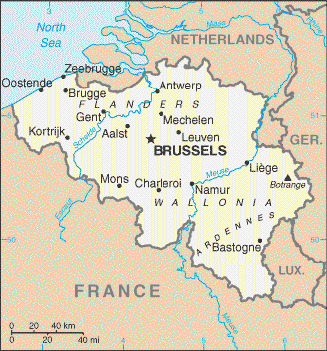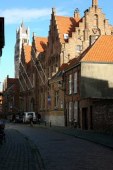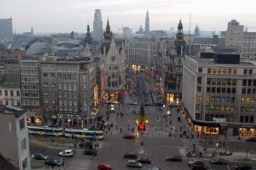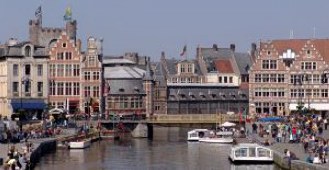Belgium
Travel The World

A country in western Europe. It is bounded on the north by the Netherlands, on the east by Germany and Luxembourg,
on the south and west by France, and on the northwest by the North Sea.
The coastline is 66.5Km long.
Country name: Belgium (Belgique/Belgie) or Kingdom of Belgium ( Royaume de Belgique/Koninkrijk Belgie). The name comes from the Belgae, a celtic tribe.
Regions: Belgium is made up of three regions: The Flemish region, the Walloon region and the Brussels region - The Brussels-Capital region is an officially
bilingual enclave within the Flemish and near the Walloon region. A small German speaking Community exists in eastern Wallonia.
The Flemish Region is subdivided into five provinces; Antwerp (Antwerpen), Limburg (Limburg), East Flanders (Oost-Vlaanderen),
Flemish Brabant (Vlaams-Brabant), West Flanders (West-Vlaanderen)
The Walloon Region is subdivided into five provinces.
The divisions between these regions are significant and they have significant autonomy from the federal government. One might argue
they are countries unto themselves. Total population for the country is 10.4 million with a paltry annual growth rate of less than one half of one percent.
Capital: Brussels
Nationality: Belgian
Ethnic groups: Fleming, Walloon, mixed and others.
Religions: Roman Catholic, Protestant and others. Belgium has no state religion.
Background:
Belgium became independent from the Netherlands in 1830;it was occupied by Germany during World Wars I and II. The country
prospered in the past half century as a modern, technologically advanced European state and member of NATO and the EU.
Tensions between the Dutch-speaking Flemings of the north and the French-speaking Walloons of the south have led in
recent years to constitutional amendments granting these regions formal recognition and autonomy. Source:The World Factbook.
Largest Cities:
Brussels
Antwerp
Ghent
Liege
Languages: Flemish (official), French (official), German, legally bilingual (Dutch and French) Belgians in the north and west
speak Flemish, a language related to Dutch. The Walloons in the southeast speak French.
Both these languages have been official state languages since 1932. In parts of the country German is spoken.
National flag of Belgium: adopted 23 January 1831
Places - towns and cities of interest
Antwerp
It's the second largest city of Belgium.
Brussels, the capital city of Belgium
The city is the administrative center of the European Union.
Brussels is more than a 1000 years old. It is a cosmopolitan city where many different cultures live together and where
different languages can be heard on each street.
Attractions:
The Grand'Place (Grote Markt). A historic market square with its splendid guild houses and the impressive Gothic beauty
of the Town Hall, the famous peeing boy, Saint Michael cathedral, the Atomium, the Palais de Justice, Bois de la Cambre
and 15th and 17th century buildings.



From left to right: Brugge, Antwerp, Ghent
Bruges ( Brugge), capital of Flanders
A medieval city known as the" Venice of the North" It was founded in the 9th century by Vikings who settled here at the end of
the little river 'de Reie'.
Gent, also known as Ghent
Ghent (Gent in Flemish, Gand in French) is the main city of East-Flanders
Attractions:
Veerleplein, the Vleeshallen, the St. Niklaas ( Nicholas) Church, the Library of the University, The medieval harbour, St. Michiels Church, St. Baafs Cathedral,
the Vrijdagmarkt, medieval architecture and the Gravensteen or Castle of the Counts of Flanders - A true medieval castle in the middle of the city! The original castle
was built around 868 by Count Baldwin I, rebuilt and expanded by the Count of Flanders around 1180.
Hasselt, the capital city of the province of Limburg.
The city lies along the Demer River near the Albert Canal, northwest of LiŤge.
Attractions:
The Japanese Garden in the Kaparmolen Park, the Saint Quintinus Cathedral, the Church of Our Lady that contains the tomb of Anne-Catherine Lamboy,
the Stellingwerff - Waerdenhof Museum, the Grote Markt, Kortrijk or Courtrai in French, a city situated in West Flanders, Belgium.
It's a city on the Leie ( Lys) river. The town was founded by the Romans.
Attractions:
Stedelijk Museum voor Schone Kunsten, the Grote Markt, the stadhuis built in 1420, the architecture, Sint-Maartenskerk, Onze-Lieve-Vrouwehospitaal, Mechelen.
The town of Mechelen (in French : Malines) is situated half-way between Brussels and Antwerp.The town was founded in the early Middle-Ages on the banks of the river Dijle.
Attractions:
St. Rumbold's tower, museums, Grote Market Square, the Town Hall, monument of Margaret of Austria, De Nekker Park, Plankendael Park
and Zoo at 582 Leuvensesteenweg, the Toy Museum, Namur, capital of Wallonia, the French speaking southern part of Belgium and the capital of Namur province.
Namur stands at the confluence of the Sambre and Meuse rivers and straddles three different regions - Hesbaye to the north, Condroz to the
south-east and Entre-Sambre-et-Meuse to the south-west.
Attractions:
The Citadel, The Meat Hall, the St. James tower, St. Albans Cathedral.
Informatie
Hoofdstad van Vlaanderen
Toen Vlaanderen een deelstaat van BelgiŽ werd, koos het Brussel als hoofdstad. Om de hechte band tussen Vlaanderen en Brussel te onderstrepen,
zijn de centrale Vlaamse instellingen in Brussel ondergebracht. Het Vlaams Parlement vergadert er
in een eigen parlementsgebouw. De zetel van de Vlaamse Regering bevindt zich aan het Martelaars plein en een groot deel
van de Vlaamse administratie is in hartje Brussel gevestigd.
Brussel is de hoofdstad van Vlaanderen, maar het is niet het Nederlands dat in de straten de hoofdtoon voert. Wie de Brusselse realiteit wil begrijpen,
moet een paar eeuwen terugkeren in de tijd. Ook de complexe manier waarop Brussel wordt bestuurd, heeft haar wortels in de geschiedenis.
Vandaag is Brussel een internationale en multiculturele stad waar het Frans de voornaamste voertaal is. Toch is de hoofdstad
van Vlaanderen in oorsprong een Nederlandstalige stad. Op een kaart van BelgiŽ springt het meteen in het oog: Brussel ligt
als een eilandje in Vlaanderen. En ook in het Brusselse dialect en in de namen van de Brusselse gemeenten Ė Schaarbeek, Anderlecht, Watermaal-Bosvoorde,
Oudergem - weerklinkt nog duidelijk het Nederlandstalige karakter van de stad. Hoofstad
Oost-Vlaanderen
De Scheldedijk in Hamme, nabij de samenvloeiing van Schelde en Durme
De Schelde straalt dynamiek uit en heeft een grote impact op elke voorbijganger. Met zijn vele wandelaars en fietsers is de Scheldedijk een uitstekende locatie.
Nabij de overzet naar Baasrode, een uitstekende stop- en wachtplaats, kan een gedicht uitstekend tot zijn recht komen.
Het dorpsplein van Mullem
De authenticiteit van het plattelandsdorp Mullem is onmiskenbaar. Het is een schilderachtig dorp met een kerk te midden van
het kerkhof, een dorpsplein, een kasteel verscholen in een parkje en enkele prachtig bewaarde hoeves.
De Weldendreef in Zevergem
Een idyllisch en ongerept stukje natuur dicht bij de stad. De dreef straalt echt het karakter
van het platteland uit ondanks de verkaveling in de buurt.
De dreef is goed toegankelijk voor fietsers en wandelaars en sluit aan op het fietsnetwerk.
Wist je dat Oost-Vlaanderen ...
is opgedeeld in 6 arrondissementen; 65 gemeenten heeft; 1 389 199 inwoners telt; en 298 224 ha groot is?
Land- en tuinbouw is een belangrijk onderdeel van onze economie en ons platteland.
Wist u bijvoorbeeld dat ruim 80 % van de azaleaís geproduceerd in Europa afkomstig zijn uit Oost-Vlaanderen?
En dat in onze provincie 11 474 voltijdse arbeidskrachten actief zijn in de land- en tuinbouw? Dat het aantal 'zorgboerderijen'
de laatste jaren sterk is toegenomen ?